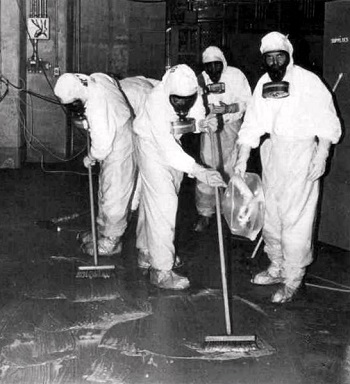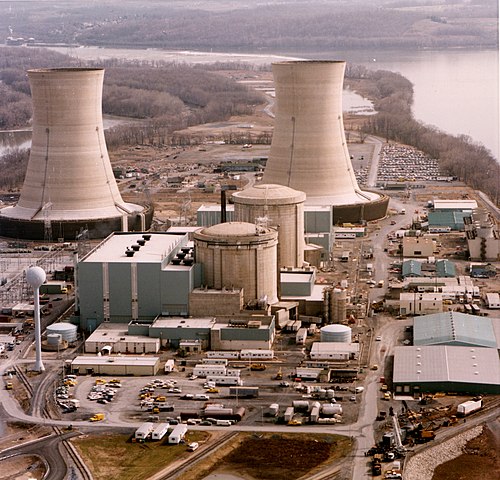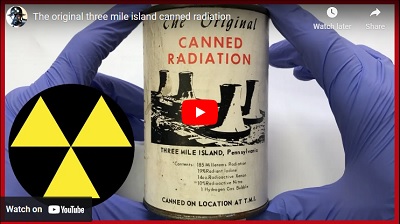In 1979 the US experienced its first serious nuclear accident – a meltdown of the Three Mile Island nuclear reactor. The event received global attention and was the start of several decades of stagnation in the American nuclear power industry. The Nuclear Regulatory Commission fact sheet on the accident is posted online at http://www.nrc.gov/reading-rm/doc-collections/fact-sheets/3mile-isle.html.
What happened:
Due to a series of mishaps, including a safety valve that stuck open, one of the reactors lost its cooling water. Although the automatic safety systems started up as designed, misleading instrument readings led the operators to shut them down and the reactor core heated up until the fuel began to melt. Radioactive gas and steam collected in the containment building, along with hydrogen gas (which was formed by a high-temperature chemical reaction between the reactor fuel and the steam). To prevent a hydrogen explosion the operators vented the hydrogen – along with some radioactive gases – to the environment and exposed some of the public to low levels of radioactivity.
Nuclide(s) and activity:
Nuclear fission produces over 100 radioactive fission products and when the fuel melts down these can released. Many of the fission products are very short-lived and many are not easily vaporized. For that reason the primary fission products released are either radioactive gases or elements that vaporize at relatively low temperatures – these include isotopes of iodine, cesium, krypton, and xenon. The primary radionuclides released from the Three Mile Island reactor were radioactive krypton and xenon (both noble gases) and small amounts of radioactive iodine; about 2.5 million curies were released, of which iodine comprised about 15 curies.
Response efforts:
The majority of response efforts focused on stabilizing the reactor plant and minimizing the amount of radioactivity released to the environment. Since the major nuclide released was a gas (krypton) there was very little contamination of the surrounding area. The state recommended evacuating pregnant women and children to a distance of 20 miles from the plant – when all was said and done over 140,000 people had evacuated the area and most of the rest sheltered in their homes. No other response efforts were needed since there was so little contamination.

Health effects:
The highest radiation dose to any member of the public was less than 100 mrem. To date there have been no injuries or health effects (short- or long-term) associated with this accident.
Other impacts:
The Three Mile Island accident had a profound impact on the American nuclear power program – until recently, no new nuclear reactor plants had been planned in three decades as a result of public reaction to the accident. In particular, the accident turned public opinion even more against nuclear reactors and nuclear energy; attitudes that persist even today. The accident also had a profound impact on the nuclear industry, especially on reactor plant design and operation – as a result of the industry and regulatory reactions to TMI today’s nuclear reactors are better-designed and operators are better-trained. Not only that, but the accident caused changes in how state, local, and federal agencies respond to nuclear and radiological accidents – many of the lessons learned from Three Mile Island are relevant to radiological terrorism.
Three Mile Island Canned Radiation
Humor often serves as a societal coping mechanism, offering an unconventional lens through which we view and process traumatic events. Whether it’s to cope, critique, or maintain public memory, gag gifts related to significant incidents like the Three Mile Island nuclear accident fulfill various emotional and social needs.
In line with this, a fascinating video below delves into a gag gift that claims to contain radiation from the Three Mile Island reactor. Packaged as a can filled with “185 million grams of radiation” among other supposed radioactive elements, the video humorously explores this controversial memento. Despite its controversial nature, the can serves as a vivid reminder of the disaster and invites us to reflect on the ways we engage with and remember such impactful events.
Further Research:
Image References:
- U.S. Dept. of Energy Color photograph of the Three Mile Island nuclear generating station, which suffered a partial meltdown in 1979. The reactors are in the smaller domes with rounded tops (the large smokestacks are just cooling towers).
- Three Mile Island personnel cleaning up radioactive contamination in the auxiliary building at the 1979 Three Mile Island nuclear accident, original image from the Report of The President’s Commission on the Accident at Three Mile Island: The Need for Change: The Legacy of TMI, p. 140.

